Today’s newsletter is flavor-packed with two recipes that seem fancy, but are so so easy to make at home. Elizabeth is showing her spin on homemade ricotta cheese by using buttermilk, and Anthony is making a Sheet Pan Ratatouille that is sure to make good use of that farmer’s market haul.
YOU GOTTA MAKE THIS RICOTTA!
EK: It’s hard to believe that it is almost August! I want to stop the clocks, or at least slow them down, because I have a million things to do before I leave for my big August trip to Slovenia! Slovenia is somewhere I have never been, but I am really excited to go for lots of reasons, including that the pace is slower. Someone told me last week, “…it’s like what Italy was 50 years ago in all the best ways.” I am taking that to mean that they are still into long, lingering meals which I am going to relish!
AU: What a fun trip ahead! I’ll be honest, I didn’t even really know where Slovenia was when you told me your were going. We can’t wait to hear about the fun experiences you’re going to have and the project that you’re working on! But first, ricotta…
EK: One fun summer I went to Sonoma with friends. We took our time exploring wineries, restaurants, shucking and eating oysters at Tomales Bay, and taking a cheesemaking class at a Point Reyes.
It was a wonderful day of touring Point Reyes, tasting their award-winning cheeses, hanging out with cows—including one that was so preggers, you could see the outline of the calf through her skin—a once in a lifetime experience for this country/city girl! Of course we also learned about how to make cheese.
When I got home, I was on a cheese-making kick and decided to make fresh ricotta, which was the easiest cheese to make in my NYC apartment. I tried making ricotta with both white vinegar and lemon juice (which are the traditional activators to “curdle” and coagulate the milk). The ricotta cheese was good and the recipe worked well, but I was looking for a better, creamier, milky, dairy cheese without any trace of vinegar or lemon tang.
Knowing that you can “recreate” the pH of buttermilk by adding vinegar or lemon to fresh milk, I thought, “Why not use buttermilk to make all the fresh milk ‘curdle’ and separate?” I mean who doesn’t love Buttermilk? The natural “sour” acidity in Buttermilk worked perfectly. I loved it!
Since that day about 13 years ago, I’ve been making it as a simple appetizer with fresh figs and honey, a spread for toasts of all sorts, or my favorite—a “dip” with fresh thyme and really, really good olive oil. If you want to go all out, a drizzle of honey with bits of aromatic truffle—real truffles, not truffle oil—from Italy is a divine riff. I particularly like this one which you can find easily in the US—and remember, a little goes a long way!
If you want to read a “deep dive” into ricotta-making, I suggest this article in SeriousEats. The author makes a recipe very different from mine with only milk, vinegar or lemon juice but I love his passion and his ricotta story.
I use three kinds of milk—whole milk, heavy cream and buttermilk. If you want to streamline it, you could use a quart of half and half and 1 1/2 cups of buttermilk. The heavier fat content in the cream/half and half makes a difference in the final flavor and creaminess of the ricotta.
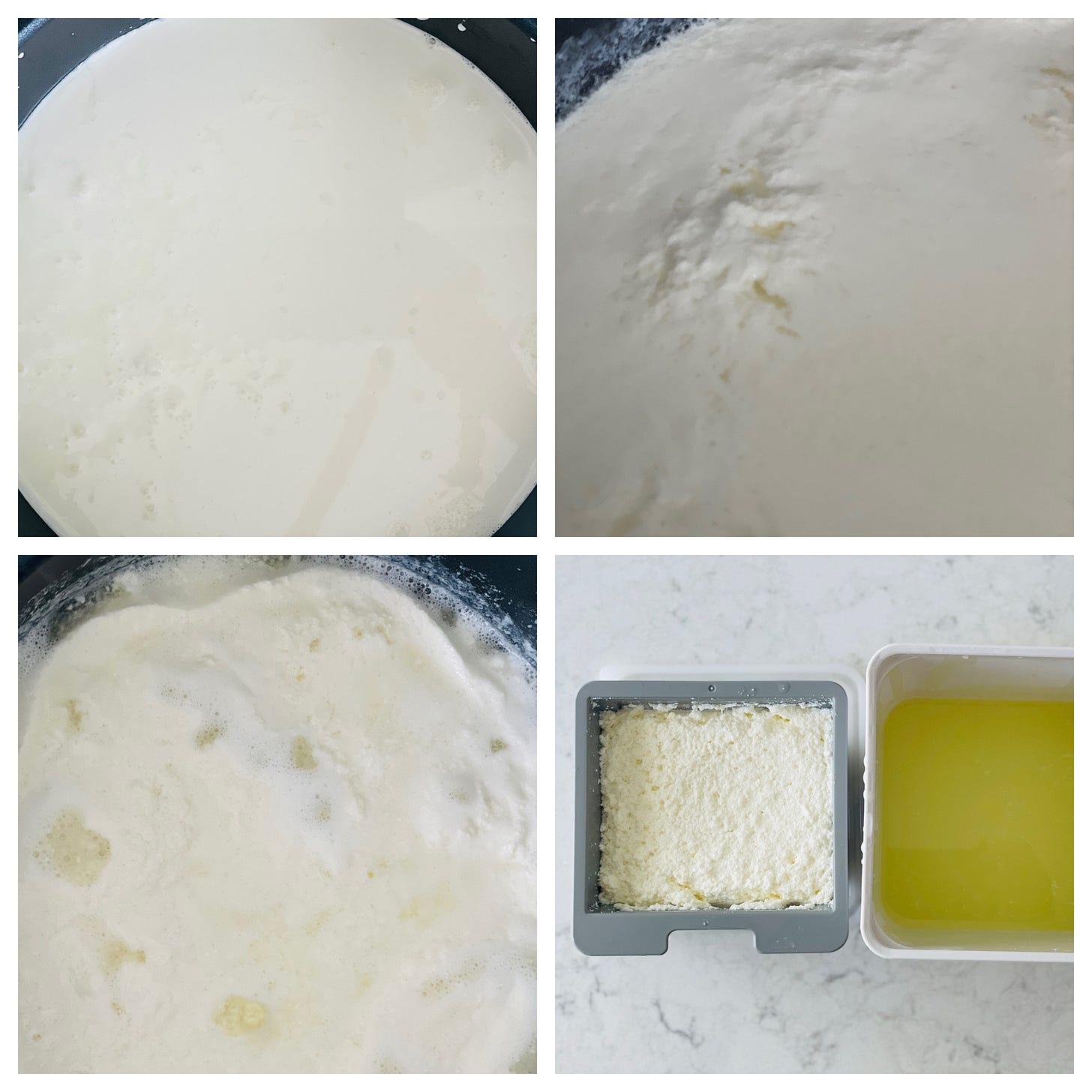
The process is simple. The mixture of milks, a touch of salt, heat, and patience is all there is to it. You pour all the milks in a heavy-duty pot and add the salt. Give it a stir, and let it simmer on a medium-low heat. Don’t be tempted to raise the temp. You want it to slowly come together, “form a raft” and separate out the curds and from the whey. The curds are the thick white “rafts” and the whey is the thin yellowish liquid. It should take about 15 minutes or so…
The final step is to separate the curds from the whey and you can do that in a bowl lined with muslin or cheesecloth, or in a handy fresh cheese press. I have the one made by Cuisipro (pictured above), because I make labneh (a yogurt cheese) a lot, which is what it is technically made for. But I discovered that it is perfect for ricotta as well.
Elizabeth’s Buttermilk Ricotta Cheese Dip
I have a lot of friends who make this ricotta cheese for their homemade lasagna but I have to be honest, since I rarely make lasagna, I only make this cheese to serve as a dip or a spread. It is a very easy recipe and the flavor and texture is so much better than store-bought ricotta that I urge you to make it yourself.It is also a fun experiment to make with kids and an easy way to make a fresh cheese at home.
3 cups whole milk
1 ½ cups buttermilk
1 cup heavy cream
¼ teaspoon kosher salt
Serving:
Fleur de sel or Pink sea salt, about 1/8th teaspoon
1-2 tablespoons of olive oil
1-2 stems of fresh herbs such as thyme, oregano, basil, or herbs de provence
Zest of ½ lemon or orange
Favorite crackers or crusty bread
Place milk, buttermilk, cream and salt in a non-reactive heavy duty saucepan over medium heat. Slowly bring contents to a gentle simmer.
As the milk solids begin to separate from the whey, give it a stir and bring it back to a gentle simmer.
When you see steam rising and solid chunks forming, turn off the heat and let the mixture cool for about 30 minutes.
Line a strainer with folded-over cheesecloth or unbleached muslin. (I prefer the muslin which is not as gauzy as cheesecloth and sometimes sold as cheesecloth. If you don’t have either, you can use paper towels but will need to change the paper towels.)
Using a ladle, spoon the ricotta into the cheesecloth until all of the curds and the whey are in the strainer. Place one layer of the cloth over the cheese. It will strain quickly at first. The longer you let it sit, the drier and more concentrated the cheese will become.
Strain cheese for 1-2 hours. I personally like it when almost all of the liquid is strained out and it has the texture of a fresh creamy cheese—not the grainy store bought texture that we are used to.
Taste and make sure you like to consistency and texture. At this point you can place in the refrigerator covered for up to 2 days.
Just before serving, place in a decorative bowl and make a well in the center. Sprinkle with salt. Pour in about 1 tablespoon of best quality olive oil. Remove leaves from herbs and sprinkle leaves around the top of the ricotta cheese. Sprinkle zest around the top of the ricotta cheese.
Serve with favorite crackers or crusty bread.
SHEET PAN RATATOUILLE
AU: I think I really fell in love with fresh vegetables when I moved to NYC. It wasn’t until I discovered the city’s incredible farmer’s markets and varied produce selection that I realized what I had been missing in my iceberg lettuce and canned green beans childhood.
EK: Would it be rude to laugh? That ‘canned green beans…’ statement conjured up such a perfect picture for me that I actually laughed out loud. Sorry not sorry!!
AU: Haha… Laugh away! Now, in Los Angeles where the growing season is three times longer, I truly appreciate veggies as the main attraction for a meal. In fact, some of my favorite restaurants here are vegetable-forward, where meat and poultry are considered as another ingredient, and not necessarily “the star” of every plate. It’s interesting how we as a society have formed habits around the old meat-and-three (meat plus three sides) meal.
EK: I am right there with you! Even though I am known for my meat cookery, the truth is that I often eat more veggies than meat on a daily basis. It’s all about balance! and there are more different veggies out there than different meats.
AU: This sheet pan ratatouille couldn’t be simpler, and it pays off in spades in the flavor department. You could easily grill all these vegetables (or even just put your sheet pans on the grill) and add them to the tomato base, but I find that roasting them on a sheet pan in the oven really makes them taste ultra-caramelized and creates a slow-simmered taste in less than 30 minutes.
EK: Did I ever tell you that ratatouille is my favorite? It’s like a chunky vegetable stew with so, so many layers of flavor. Your sheet-pan version has to be insane, because you are adding roasting and caramelization to the equation. I am making this ASAP!
AU: The key, like all sheet pan meals, is to cut everything in a relatively similar size, so they cook at the same rate. While the veggies are roasting away in the oven, I simmer peak season tomatoes in olive oil ‘til they’re a chunky fresh tomato sauce. Then you just combine the veg and the sauce, adding a touch of Sherry vinegar and some herbes de provence. It’s a ratatouille that is insanely good on its own, served with crusty bread and some of Elizabeth’s buttermilk ricotta, or you could toss it with pasta to stretch it out.
SHEET PAN RATATOUILLE
I’m not sure how an old French grand'mere makes ratatouille in Provence, but I do know what tastes delicious, and this is it! Make use of your farmer’s market haul in this simple, fresh, and comforting ratatouille. Roasting most of the vegetables on sheet pans while fresh tomatoes simmer in some garlic and olive oil on the stovetop makes an incredibly easy and mostly-hands-off vegetarian meal. I like to serve this with some great crusty bread and fresh ricotta or whipped feta.
Serves 4
Ingredients:
4 small zucchini, summer squash, or combination of both, sliced into ¼” half moons
2 large shallots, sliced into ¼” thick rings
4 garlic cloves, roughly chopped; divided
1 red onion, sliced into ¼”-thick pieces
1 Japanese eggplant (2 if small), 1” dice
2 red bell peppers, ½” dice
3 large heirloom tomatoes (or 4 medium), roughly chopped into 1” pieces
¼ cup olive oil, plus more for roasting vegetables
1 tablespoon Sherry vinegar
1 ½ teaspoons dried Herbes de Provence
Fresh basil or parsley, for garnish
Kosher Salt & Freshly Ground Black Pepper
Preheat the oven to 425ºF. Toss zucchini, shallots, and two of the chopped garlic cloves with olive oil and season with kosher salt and black pepper. Spread in an even layer on a rimmed baking sheet. Repeat the same process on another rimmed baking sheet with the red onion, red bell peppers, eggplant, and remaining two chopped cloves of garlic. Keep eggplant separate on the sheet pan, as it may brown slightly faster than the other vegetables.
Roast vegetables at 425ºF for 25 minutes, tossing them halfway through cooking (checking eggplant for doneness at 20 minutes). The vegetables are finished roasting when they are nicely caramelized and have slightly brown edges. Remove vegetables from the oven as they are done and set aside until tomato sauce is ready.
Meanwhile in a 5-quart dutch oven over medium-high heat, cook chopped tomatoes in ¼ cup of olive oil until they just begin to break down, about 5 minutes. Reduce heat to a simmer, add herbes de provence, and season with salt and pepper. Simmer until tomatoes are reduced into a thick sauce, about 25 minutes.
Once the tomato mixture is cooked to your preferred consistency, stir in Sherry vinegar. Add roasted vegetables to the pot (including any juices that may have accumulated on the sheet pans), and gently stir to combine. Let everything meld for about 10 minutes on low heat. Taste for seasoning, add chopped parsley or torn basil for garnish, and serve.
That’s it for this week! As always, if you make our recipes, tag us on the ‘gram (@kitchensitch & @elizabethkarmel), and use the hashtag #whats4dinner. Happy cooking!!

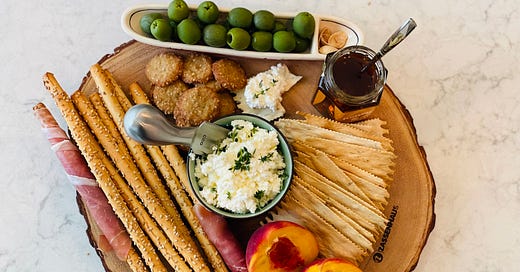




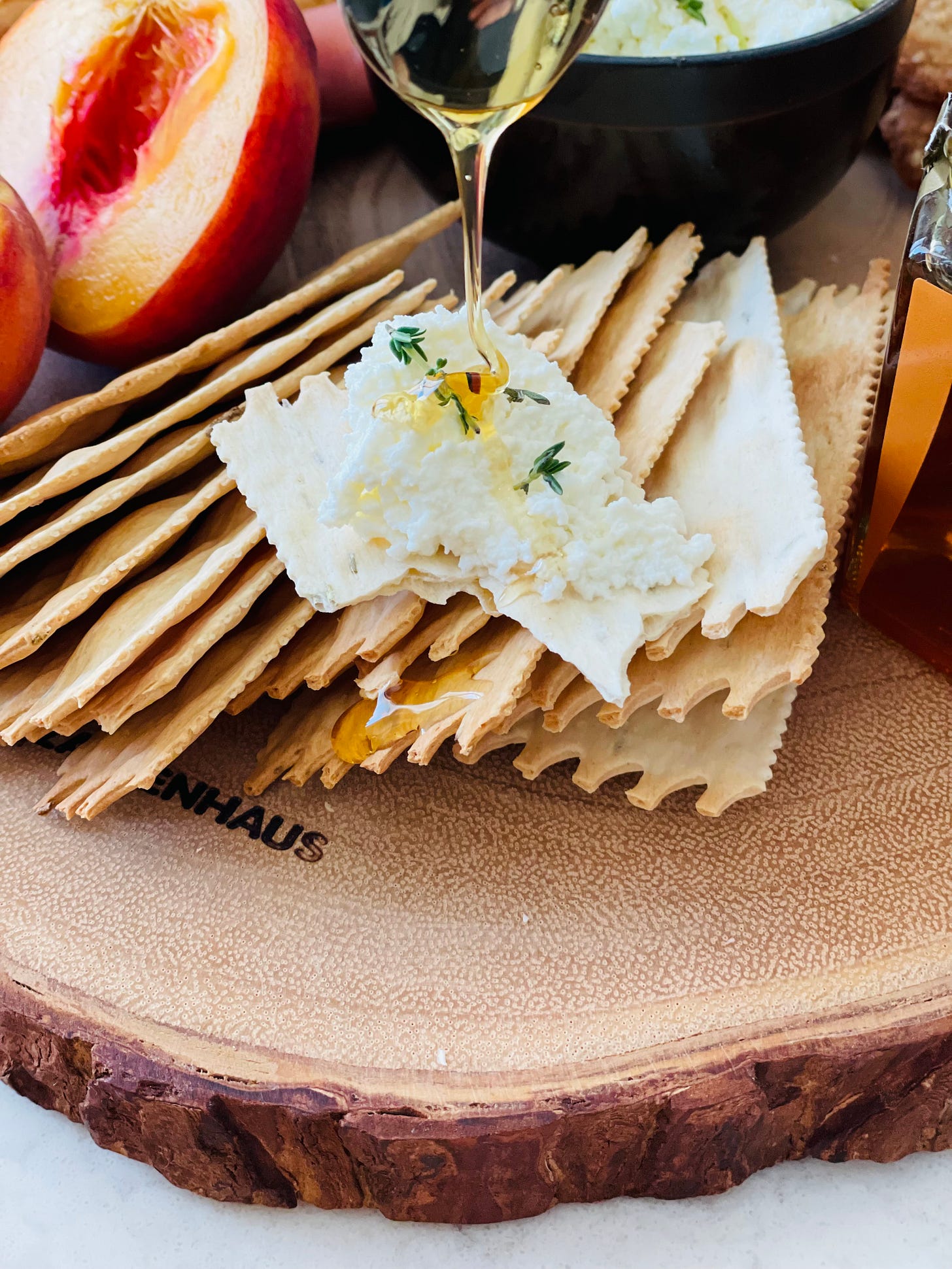
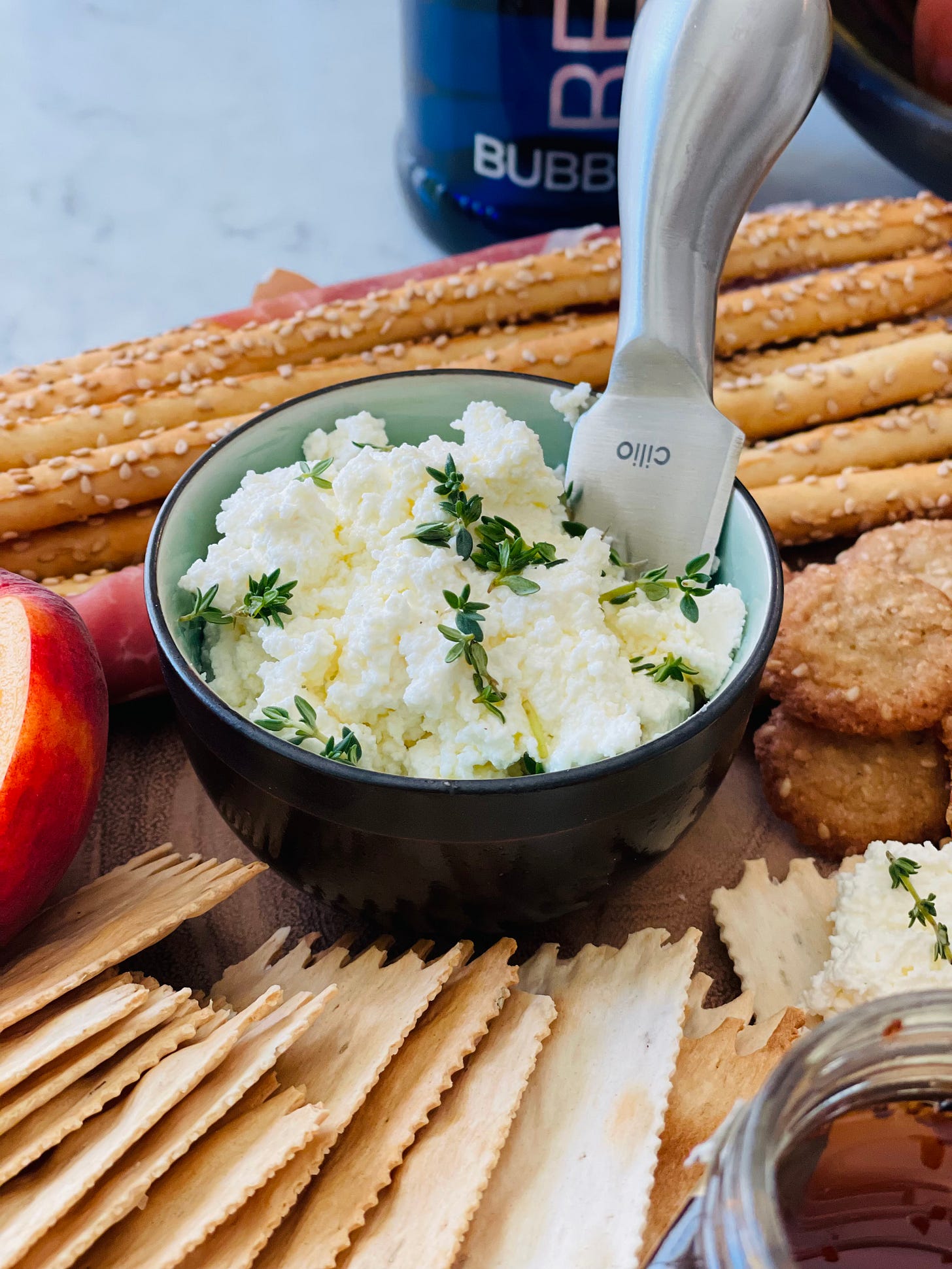
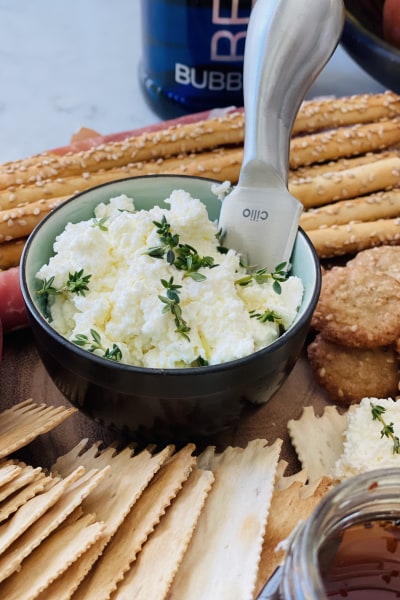
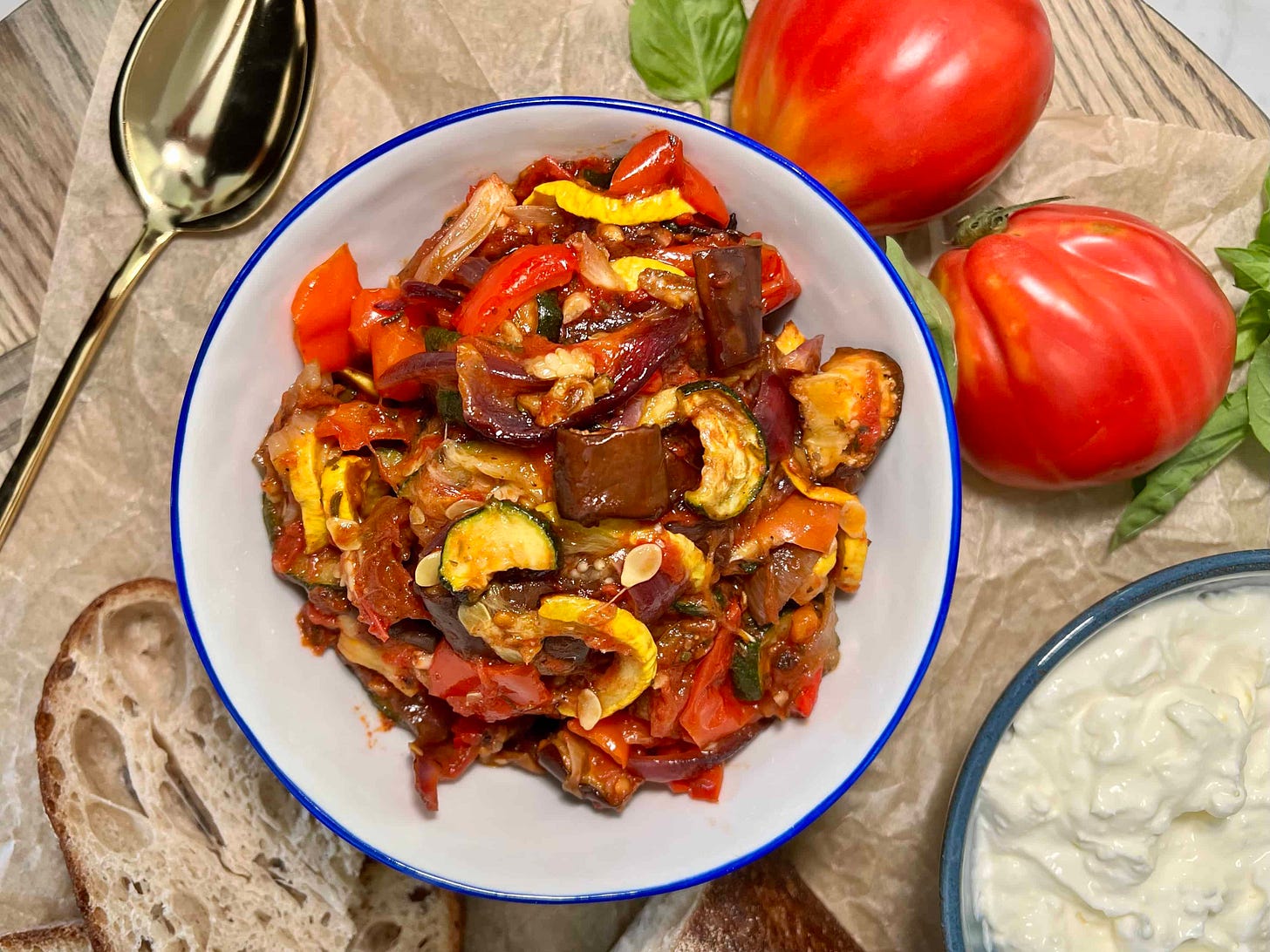
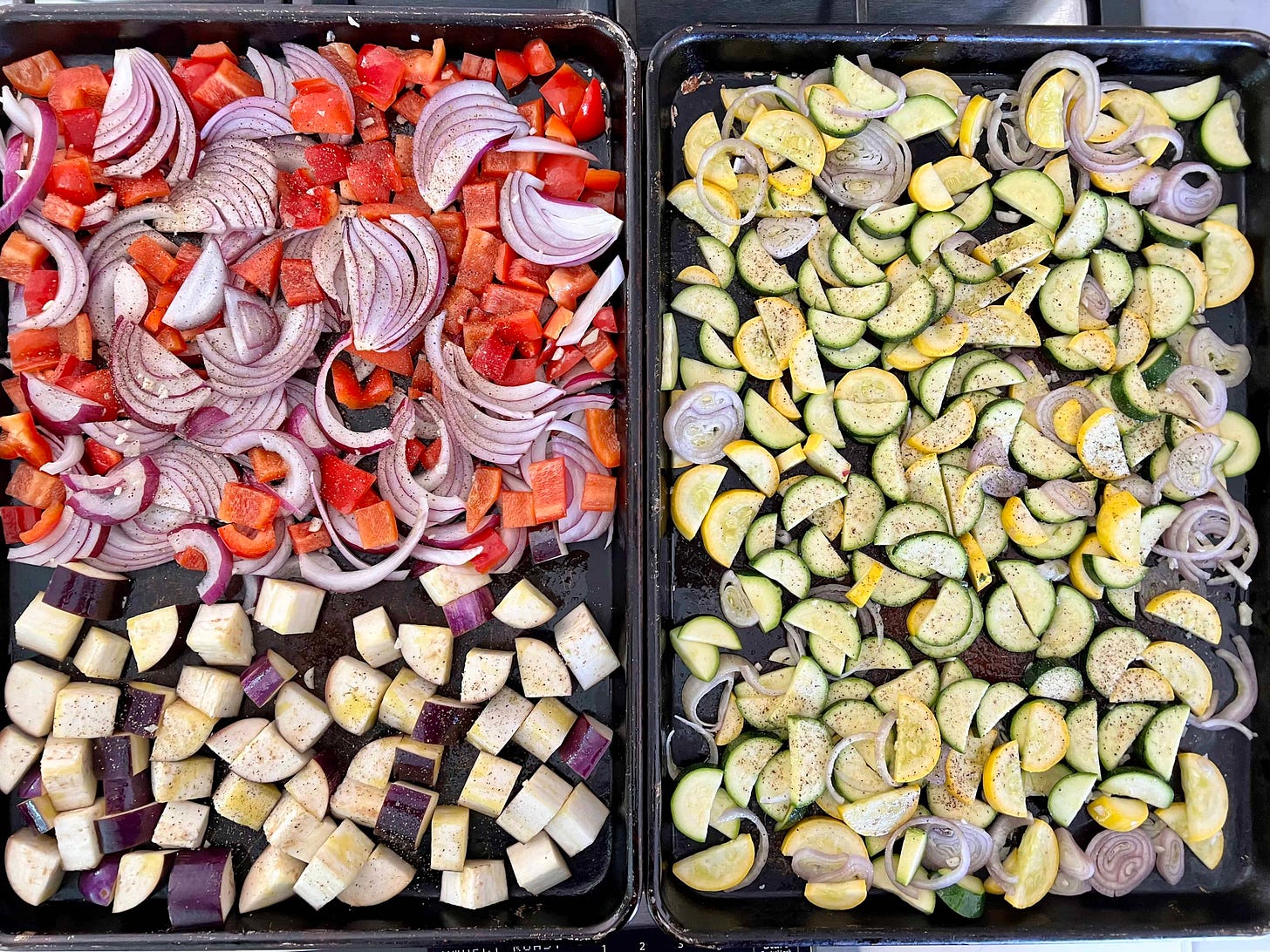
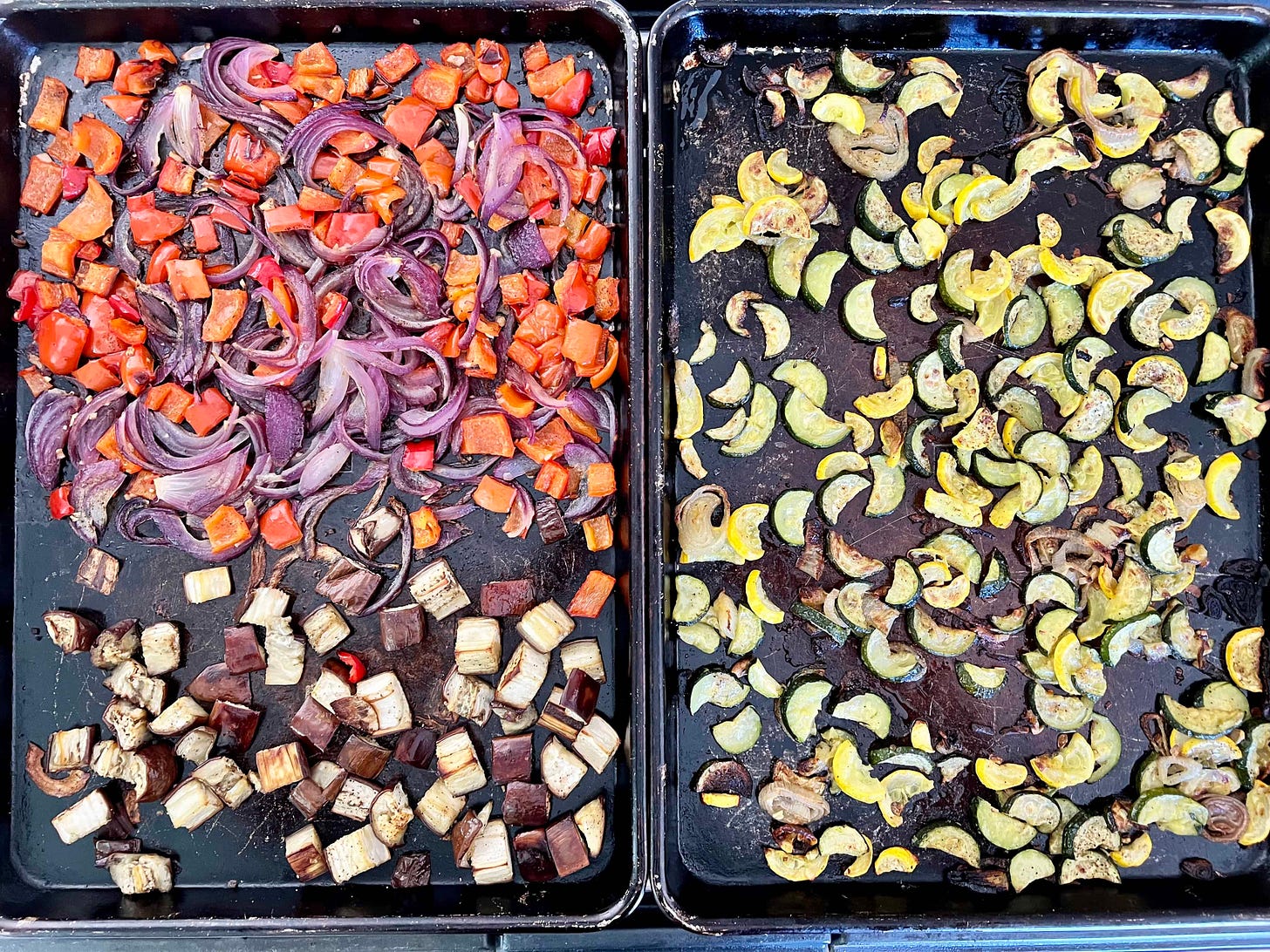
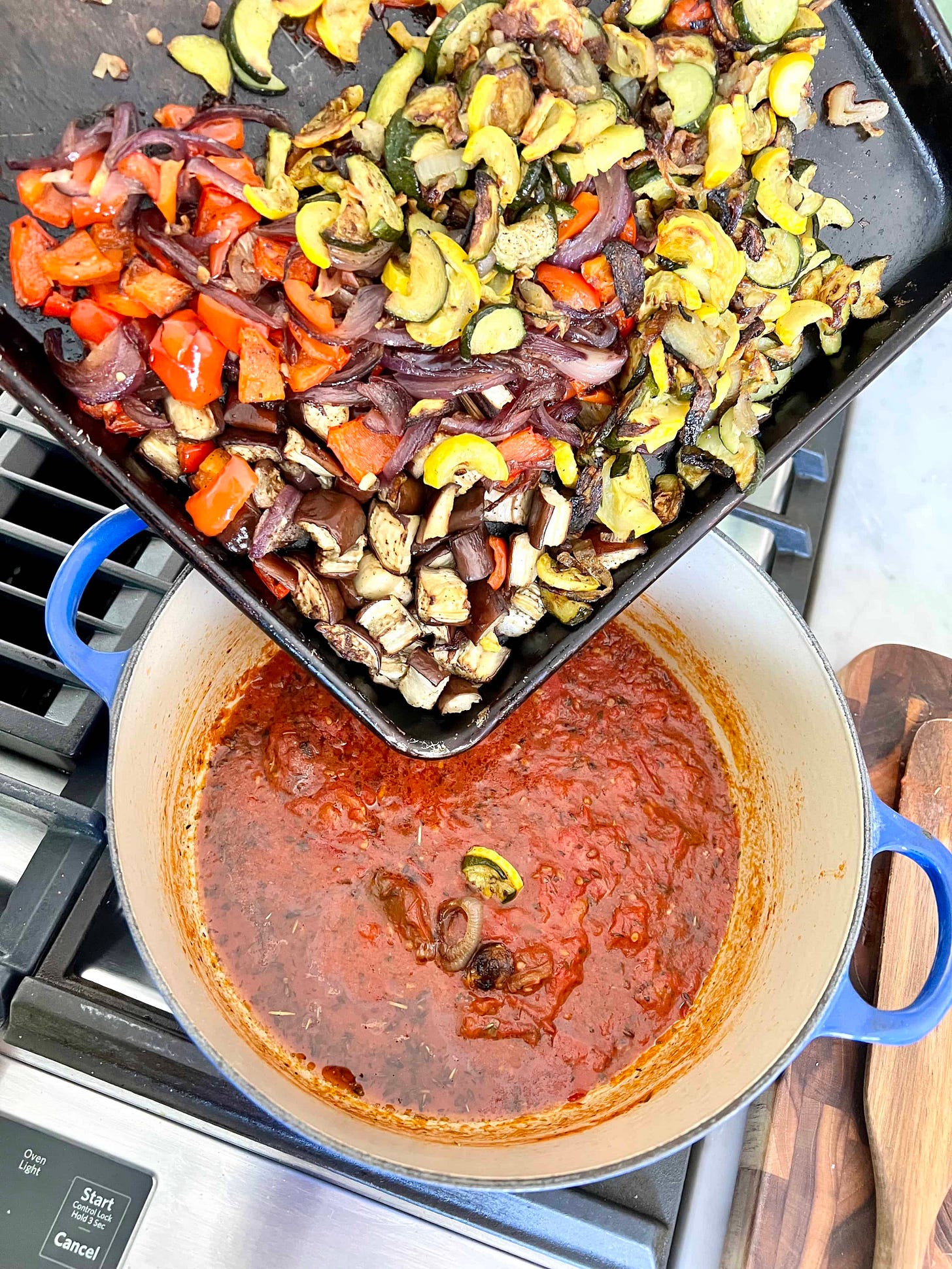
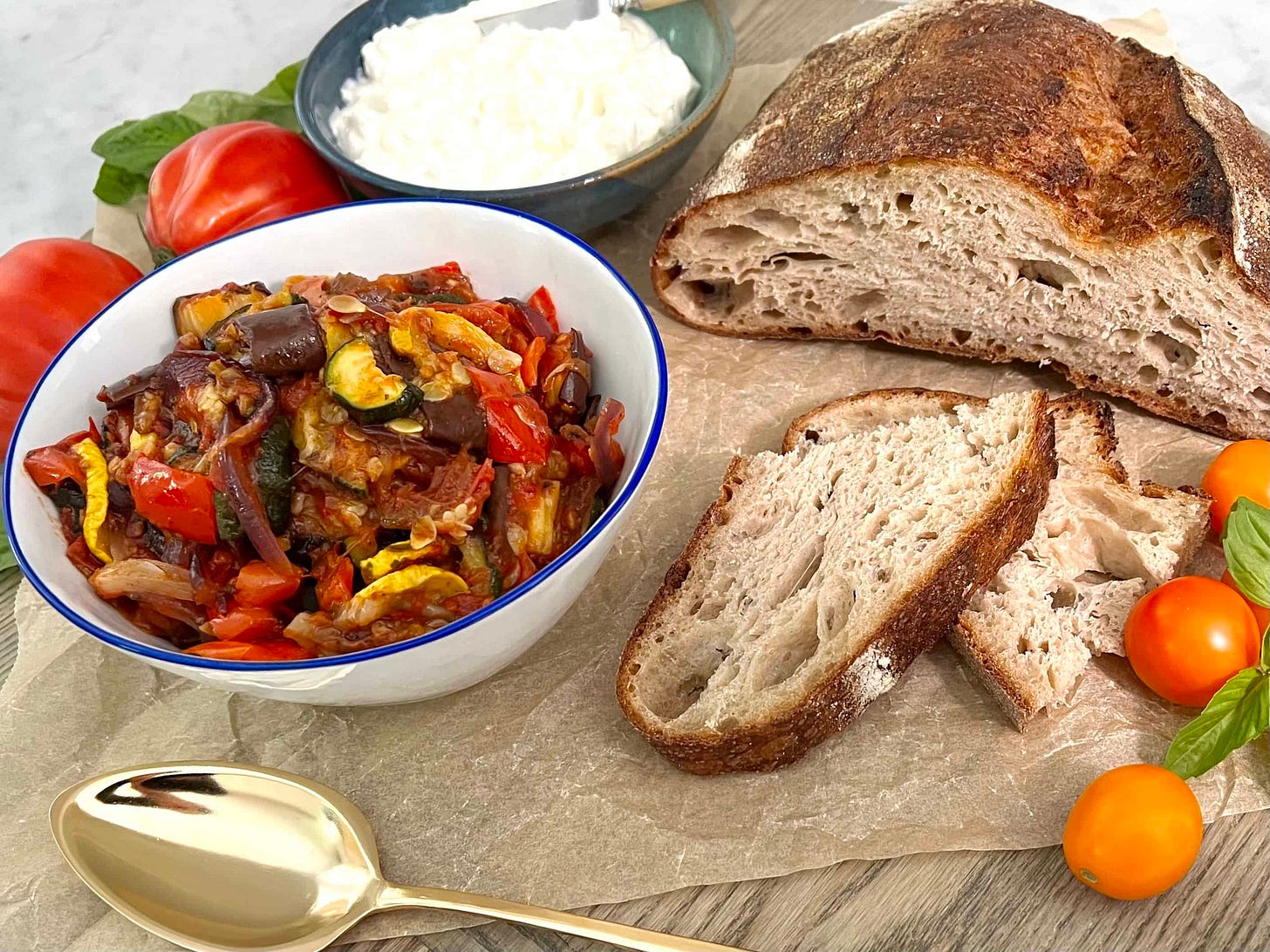
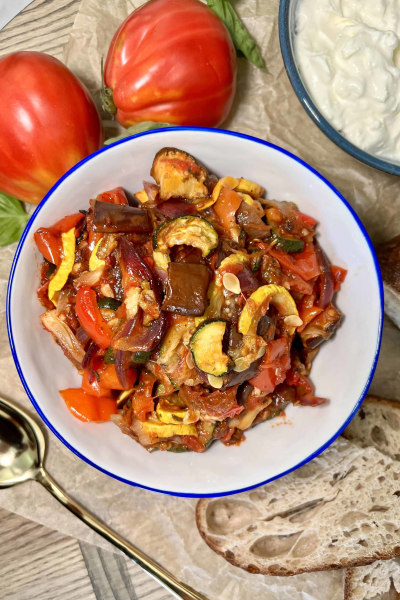
My kinda supper!
Another use for ricotta: Elizabeth Minchilli’s strawberry (or other fruit) ricotta cake which was popular the 1st covid summer